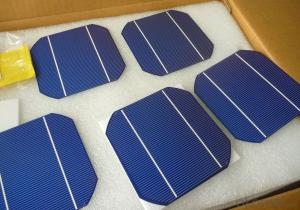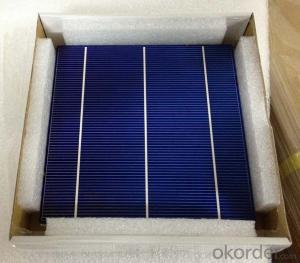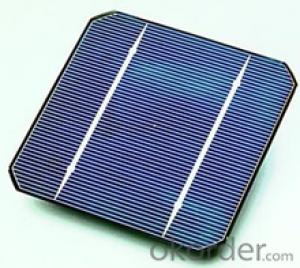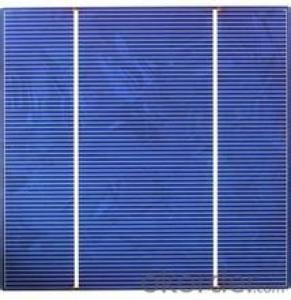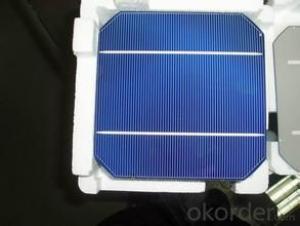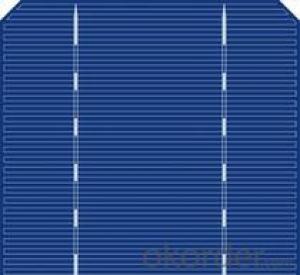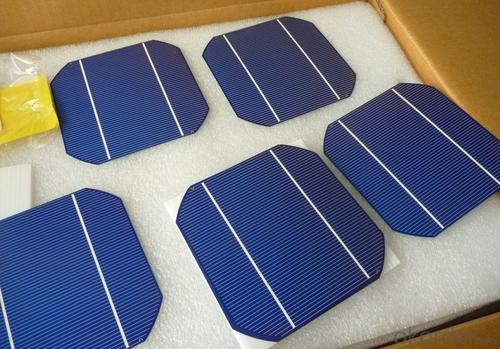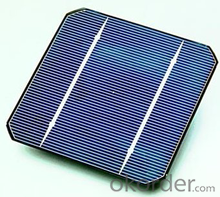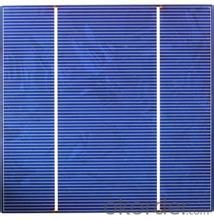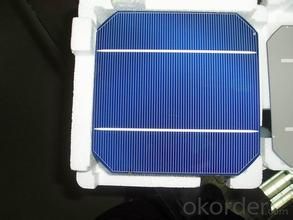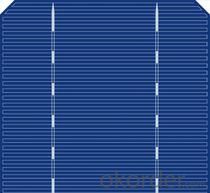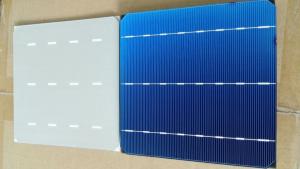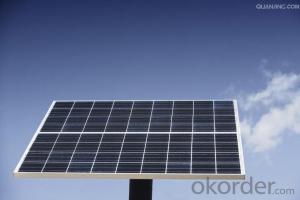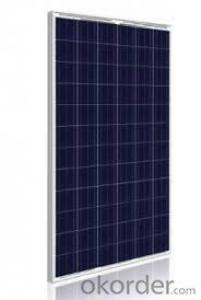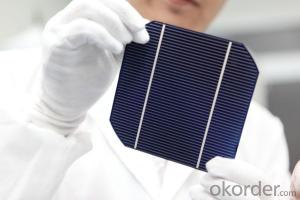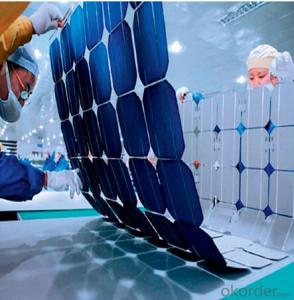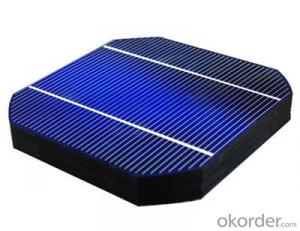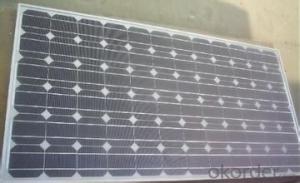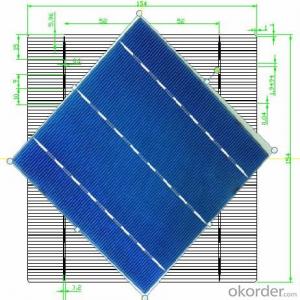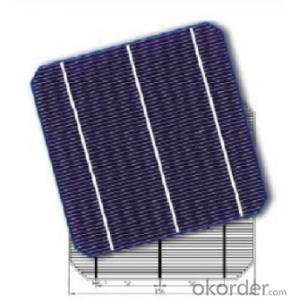Solar Cells for Boats - Monocrystalline Silicon Solar Cells 156mm (14.00%-17.25%)
- Loading Port:
- Shanghai
- Payment Terms:
- TT OR LC
- Min Order Qty:
- 1000 watt
- Supply Capability:
- 100000000 watt/month
OKorder Service Pledge
OKorder Financial Service
You Might Also Like
Specification
1.Description of the Solar Cells
Monocrytalline Silicon Solar Cells 156mm (14.00%----17.25%)
We supply regular mono 125x125mm and poly 156x156mm solar cells.
Cells made in China mainland and Taiwan are both available.
Cell production capacity yearly reach 1GW.
Our cells pattern include continuous and uncontinuous busbar to meet different cells line.
2.Mechanical data and design of the Solar Cells
| Format | 156 mm × 156 mm ± 0.5 mm |
| Thickness- | 210 μm ± 40 μm |
| Front (-) | 1.5 mm bus bars (silver),blue anti-reflection coating (silicon nitride) |
| Back (+) | 2.5 mm wide soldering pads (silver) back surface field (aluminium) |
3. Temperature Coefficient of the Solar Cells
| Voc. Temp .coef.%/K | -0.351%/K |
| Isc . Temp .coef.%/K | +0.035%/K |
| Pm. Temp. coef.%/K | -0.47%/K |
4.Electrical Characteristic of the Solar Cells
Efficiency (%) | Pmpp (W) | Umpp (V) | Impp (A) | Uoc (V) | Isc (A) | FF (%) | ||
17.25 | 4.197 | 0.524 | 7.992 | 0.62 | 8.458 | 80.03% | ||
17 | 4.137 | 0.524 | 7.876 | 0.619 | 8.353 | 80.01% | ||
16.75 | 4.076 | 0.522 | 7.81 | 0.617 | 8.286 | 79.73% | ||
16.5 | 4.015 | 0.518 | 7.746 | 0.613 | 8.215 | 79.73% | ||
16.25 | 3.955 | 0.515 | 7.683 | 0.61 | 8.144 | 79.61% | ||
16 | 3.894 | 0.512 | 7.613 | 0.608 | 8.075 | 79.31% | ||
15.75 | 3.833 | 0.51 | 7.534 | 0.605 | 8.058 | 78.62% | ||
15.5 | 3.772 | 0.508 | 7.453 | 0.604 | 8.02 | 77.87% | ||
15.25 | 3.711 | 0.505 | 7.35 | 0.604 | 7.997 | 76.83% | ||
15 | 3.65 | 0.503 | 7.271 | 0.604 | 7.989 | 75.64% | ||
14.5 | 3.529 | 0.499 | 7.067 | 0.604 | 7.988 | 73.14% | ||
14 | 3.407 | 0.499 | 6.833 | 0.604 | 7.833 | 72.01% | ||
5.Intensity Dependence of the Solar Cells
Intensity [W/m2] | sc× [mA] | Voc× [mV] |
1000 | 1.00 | 1.000 |
900 | 0.90 | 0.989 |
500 | 0.50 | 0.963 |
300 | 0.30 | 0.939 |
200 | 0.20 | 0.920 |
6.Applications of the Solar Cells
electric power generation
7.IMages of the Solar Cells
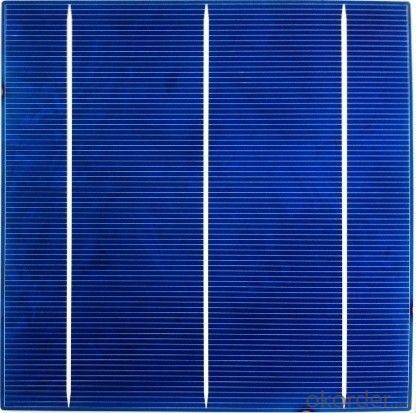
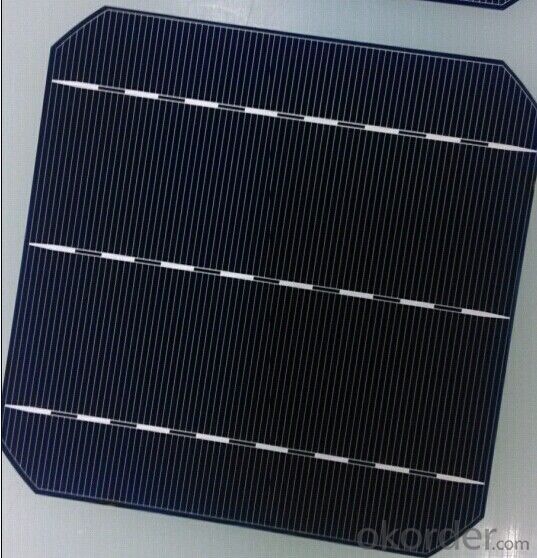
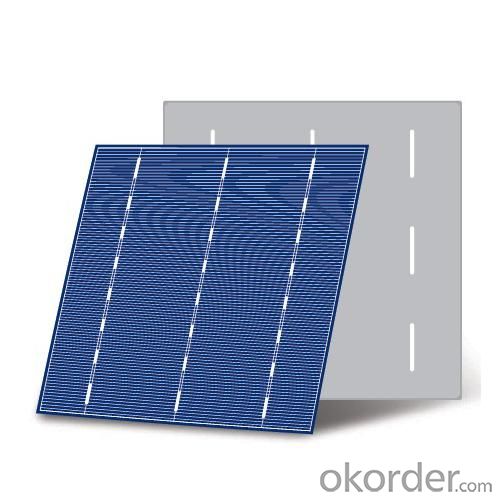
FAQ
- Q: Are there any subsidies or incentives for installing solar cells?
- Yes, there are subsidies and incentives available for installing solar cells. Many governments and local authorities offer financial incentives such as tax credits, grants, and rebates to encourage the adoption of solar energy. Additionally, some utility companies provide feed-in tariffs or net metering programs, which allow solar system owners to sell excess electricity back to the grid or receive credits on their energy bills. These subsidies and incentives aim to make solar installations more affordable and promote the transition to clean and renewable energy sources.
- Q: How do solar cells impact air pollution?
- Solar cells have a significant positive impact on air pollution as they generate clean, renewable energy without emitting harmful pollutants or greenhouse gases. By reducing our reliance on fossil fuels, solar cells help mitigate air pollution and improve the overall air quality, leading to better health outcomes and a healthier environment.
- Q: How do solar cells handle electromagnetic fields from power lines?
- Solar cells are not affected by electromagnetic fields from power lines as they are designed to convert sunlight into electricity and not sensitive to external electromagnetic interference.
- Q: Can solar cells be used for powering data centers?
- Yes, solar cells can be used for powering data centers. Solar energy can be harnessed through photovoltaic cells and converted into electricity, which can then be used to power data centers. This renewable energy source is increasingly being adopted by data centers to reduce their carbon footprint and energy costs.
- Q: What is the role of silicon in solar cells?
- The role of silicon in solar cells is to act as a semiconductor material that can absorb sunlight and convert it into electricity through the photovoltaic effect. Silicon is the most commonly used material in solar cell manufacturing due to its abundance, stability, and ability to efficiently convert sunlight into electricity. It forms the basis of the p-n junction, which allows for the separation and movement of electrons and holes, generating an electric current.
- Q: Can solar cells be used in mining operations?
- Yes, solar cells can be used in mining operations. They can provide a reliable and sustainable source of electricity for various mining activities, such as powering equipment, lighting, and ventilation systems. Solar energy can significantly reduce the dependence on fossil fuels in mining operations, leading to lower operational costs and reduced environmental impact.
- Q: Can solar cells be used in space stations?
- Yes, solar cells can be used in space stations. In fact, they are commonly used to provide power to space stations by converting sunlight into electricity.
- Q: What is the typical lifespan of a solar cell?
- The typical lifespan of a solar cell is around 25 to 30 years, although some high-quality solar panels can last up to 40 years with proper maintenance and care.
- Q: Can solar cells be used in street lighting?
- Yes, solar cells can be used in street lighting. Solar-powered street lights utilize solar panels to convert sunlight into electricity, which is then stored in batteries. This stored energy is used to power the street lights during the night, making them a sustainable and cost-effective lighting solution for streets.
- Q: Can solar cells be used in telecommunications?
- Yes, solar cells can be used in telecommunications. They can provide a reliable and sustainable source of power for telecommunication equipment, especially in remote or off-grid areas where access to electricity may be limited. Solar cells can be utilized to charge batteries or directly power telecommunication systems, ensuring continuous operation and reducing reliance on traditional energy sources.
Send your message to us
Solar Cells for Boats - Monocrystalline Silicon Solar Cells 156mm (14.00%-17.25%)
- Loading Port:
- Shanghai
- Payment Terms:
- TT OR LC
- Min Order Qty:
- 1000 watt
- Supply Capability:
- 100000000 watt/month
OKorder Service Pledge
OKorder Financial Service
Similar products
Hot products
Hot Searches
Related keywords
